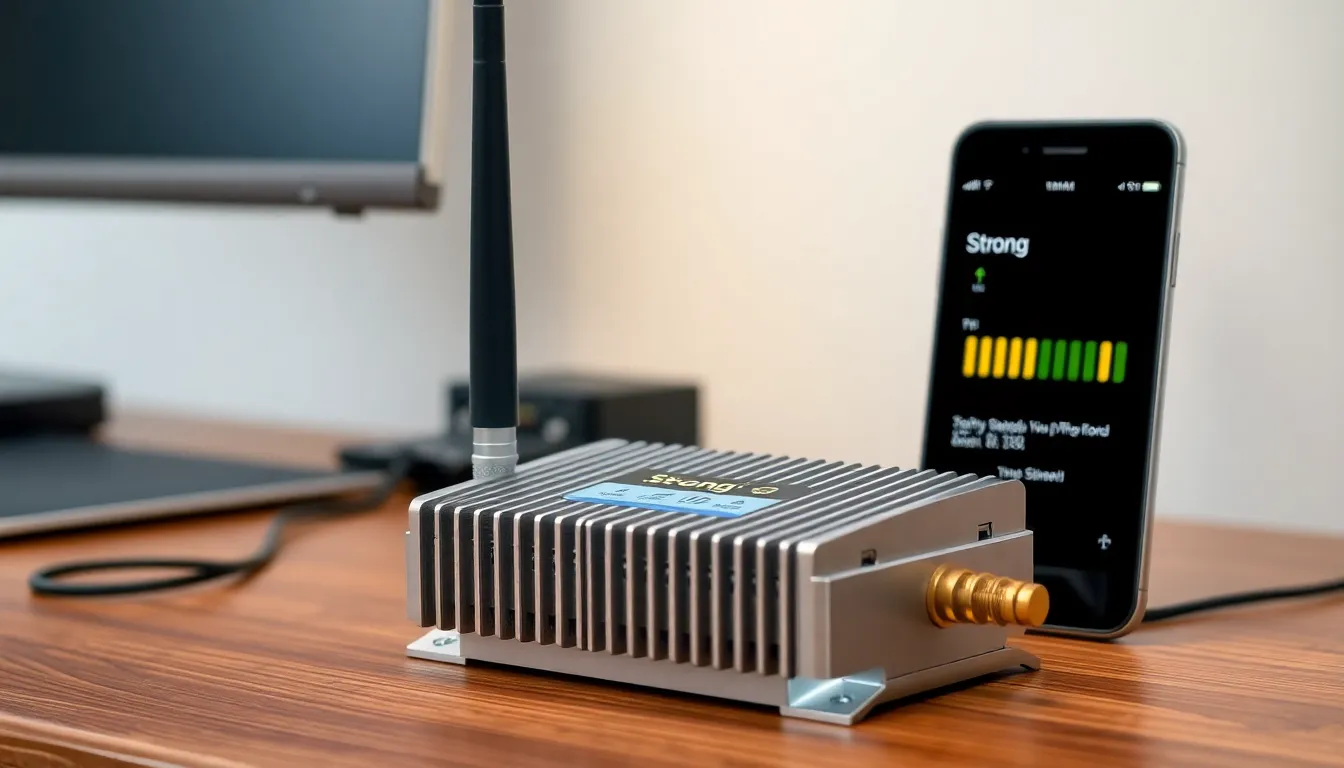In a world where dropped calls and buffering videos can feel like the modern-day equivalent of a medieval torture device, cell phone signal boosters come to the rescue. Imagine a life where your phone actually works—no more yelling “Can you hear me now?” into the void or watching your favorite show pixelate into oblivion. These nifty little gadgets amplify weak signals, transforming frustrating moments into seamless communication.
Whether you live in a rural area where cell towers are as rare as unicorns or just want to eliminate those pesky dead zones in your home, a signal booster could be your new best friend. It’s time to ditch the drama of poor reception and embrace the clarity of a strong signal. Let’s dive into the world of cell phone signal boosters and discover how they can revolutionize your connectivity experience.
Table of Contents
ToggleOverview of Cell Phone Signal Boosters
Cell phone signal boosters enhance weak signals, improving communication quality significantly. These devices consist of three main components: an external antenna, an amplifier, and an internal antenna. The external antenna captures weak signals from nearby cell towers.
An amplifier boosts these signals, maintaining their strength as they travel. The internal antenna then redistributes the enhanced signals within a designated area, providing improved coverage for users.
Signal boosters benefit various environments, especially rural areas and locations with substantial building interference. Users experiencing dropped calls or slow internet speeds see marked improvements when utilizing these devices. According to the Federal Communications Commission, signal boosters can increase cellular range by up to 32 times, depending on the model and installation quality.
Installation typically involves placing the external antenna in an optimal position, often on rooftops or high windows, to maximize signal capture. This setup allows for efficient amplification and coverage throughout homes or offices.
Maintaining these full functionalities requires ensuring adequate distance between the external and internal antennas to avoid oscillation. Consult manufacturers’ guides for specific installation instructions and maintenance tips. Whether for personal use or in commercial applications, signal boosters provide a cost-effective solution to enhance connectivity, ensuring reliable service where it’s typically lacking.
How Cell Phone Signal Boosters Work

Cell phone signal boosters enhance weak signals, ensuring clearer communication and fewer interruptions. Understanding how these devices function provides insight into their effectiveness.
Types of Signal Boosters
Signal boosters come in different types, catering to various needs. Mobile boosters enhance signals for cars or trucks, allowing users to stay connected while on the move. Home boosters improve connectivity in residences, offering coverage for larger areas. Commercial boosters serve businesses, ensuring reliable service across offices or warehouses. Each type addresses specific scenarios, optimizing performance and reliability.
Key Components of a Signal Booster
Key components form the heart of a cell phone signal booster system. An external antenna captures weak signals from nearby cell towers. This antenna connects to the amplifier, which strengthens the signals for improved clarity. An internal antenna distributes the boosted signals throughout the designated area. Proper installation of these components ensures maximum efficiency, enhancing the overall user experience.
Benefits of Using Cell Phone Signal Boosters
Cell phone signal boosters offer numerous advantages that enhance users’ overall experience with mobile connectivity.
Improved Call Quality
Improved call quality becomes noticeable with the use of signal boosters. Users experience fewer dropped calls, which results in more reliable conversations. Clarity in voice calls increases significantly, especially in areas with poor reception. Enhanced signals reduce background noise, making dialogue easier to understand. It’s easier for individuals to communicate effectively without interruptions. Overall, customers feel more satisfied with their mobile devices when call quality improves due to these boosters.
Increased Data Speeds
Increased data speeds represent another key benefit of cell phone signal boosters. Users often notice faster downloads and uploads with a stronger signal. Video streaming becomes smoother, eliminating the frustrating buffering that often disrupts entertainment. Various online activities, such as browsing and gaming, become more enjoyable and efficient. When data speeds increase, users can work and play without the interruptions caused by weak signals. This boost in connectivity transforms how individuals engage with technology.
Extended Battery Life
Extended battery life is another advantage cell phone signal boosters provide. When a phone struggles to connect to weak signals, the battery drains faster as it exhausts more power searching for service. Improved signal strength allows devices to maintain better connections with less effort, conserving battery life. Users spend less time charging their phones and have more freedom to use their devices throughout the day. Overall, enhanced connectivity with a signal booster means longer usage without the constant need to recharge.
Factors to Consider When Choosing a Signal Booster
Choosing the right signal booster involves several critical factors that impact performance and effectiveness. Evaluating these aspects ensures that users select an appropriate device for their needs.
Coverage Area
Coverage area plays a vital role in determining the effectiveness of a signal booster. Most models specify the square footage they can cover, which typically ranges from 1,500 to 10,000 square feet. Users need to assess the size of the area where signal enhancement is required. Analyze common spaces such as homes, offices, or vehicles. Furthermore, consider any barriers like walls that might obstruct signals. Identifying the exact coverage needs helps in selecting a booster that can adequately serve the intended space.
Frequency Compatibility
Frequency compatibility is another critical aspect when choosing a signal booster. Different cellular networks operate on various frequency bands, and boosters must be compatible with those bands to enhance signals effectively. The most common bands include GSM, CDMA, and LTE. Users should identify their service provider’s frequency specifications before making a purchase. Doing so ensures optimal performance and enhances call quality across devices. Additionally, some boosters support multiple bands, offering versatility for households with different carriers.
Installation Process
The installation process can vary significantly between signal boosters. Some units require professional installation, while others can be set up by the user without specialized knowledge. Basic components usually include an external antenna, an amplifier, and an internal antenna. Users should carefully follow the setup instructions for optimal results. A crucial part of the installation involves placing the external antenna in a location that captures the strongest signal. Sustaining a proper distance between the external and internal antennas prevents feedback issues and guarantees a stable signal throughout the designated area.
Cell phone signal boosters represent a practical solution for anyone struggling with poor connectivity. By addressing weak signals and enhancing communication, these devices can transform frustrating experiences into seamless interactions. With various types available, users can find the right booster tailored to their specific needs, whether at home, in a vehicle, or within a business setting.
Investing in a signal booster not only improves call quality and data speeds but also extends device battery life. As technology continues to evolve, the importance of reliable connectivity remains paramount. Embracing the benefits of signal boosters can lead to a noticeable improvement in daily communication and overall user satisfaction.



